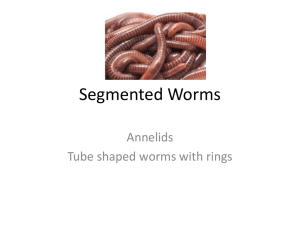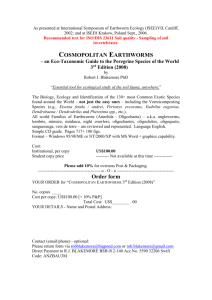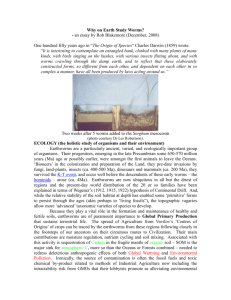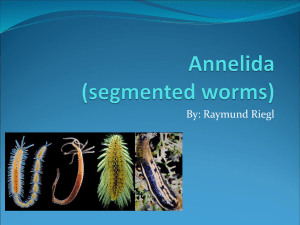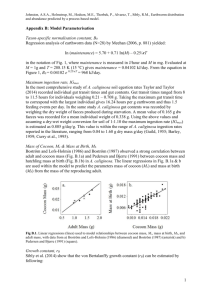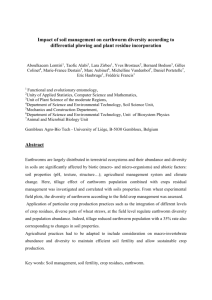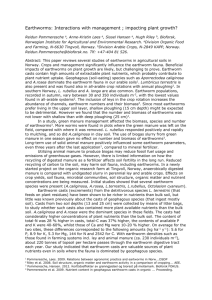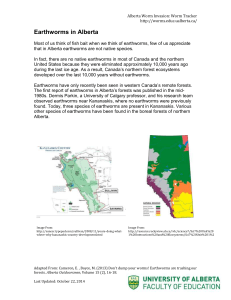Biology Project: Earthworms
advertisement
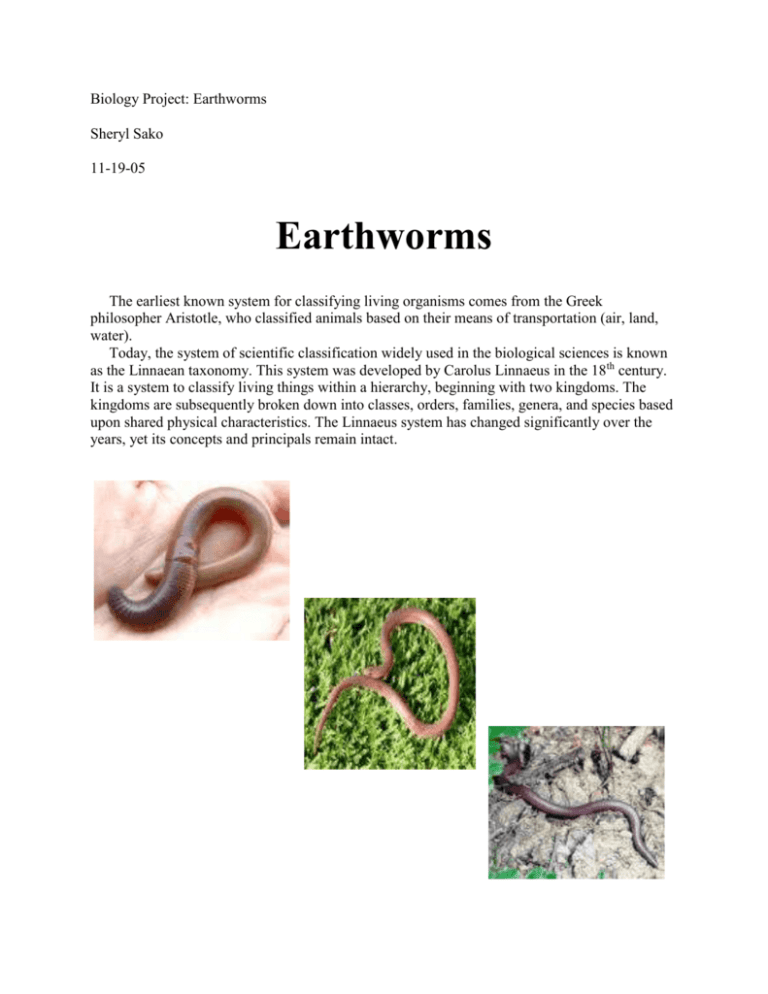
Biology Project: Earthworms Sheryl Sako 11-19-05 Earthworms The earliest known system for classifying living organisms comes from the Greek philosopher Aristotle, who classified animals based on their means of transportation (air, land, water). Today, the system of scientific classification widely used in the biological sciences is known as the Linnaean taxonomy. This system was developed by Carolus Linnaeus in the 18th century. It is a system to classify living things within a hierarchy, beginning with two kingdoms. The kingdoms are subsequently broken down into classes, orders, families, genera, and species based upon shared physical characteristics. The Linnaeus system has changed significantly over the years, yet its concepts and principals remain intact. Taxonomy (Hierarchical classification of living things) Kingdom - Animalia - Multicellular Heterotrophs (This category is the broadest category of all living things) Phylum - Annelida - Invertebrate, animals that are segmented, with no visible head, eyes, teeth. (This category narrows down the kingdom to animals with certain evolutionary traits) Class - Oligochaeta - Oligo - meaning few, Ghaeta - meaning setae. Animals that have a few setae (spine like hairs extending from the body). Terrestrial Worms. (This category narrows Phylum down to animals with shared physical traits) Order - Haplotaxida - (This category separates class into animals with similar behavior and habits) Family - Lumbricidae - (This category narrows to a specific group of earthworms, it includes most of the well known earthworm species) Genus - Lumbricus - A group of animals that has one or more closely related biological species. This category includes 4 different earthworm species, 1) Rubells 2) Terrestris 3) Festives 4) Custaneus. (This category breaks down to specific characteristics the group has in common). They are strongly pigmented, brown red dorsally, and yellowish venbally, and setae is widely paired at both ends. This group contains the largest species of earthworms. Species - Terrestris - Nightcrawler Earthworm (This is the set of actually or potentially interbreeding natural populations which are reproductively isolated from other such groups. Each member of the species also possesses similar anatomical characteristics.) Origin Of The Species Thousands of years ago when the earth was mostly water and rocky surface, earthworms were aquatic. It wasn’t until the waters receded and soil formed that the worm, as well as many other aquatic life forms evolved and adapted to their changing environment. The earthworms primitive physiology has gone basically unchanged since it’s adaptation to land. It is one of the few species on earth that has evolved very little over the centuries. Our planet almost lost the earthworm species during the last Ice Age when it was almost entirely wiped out. Luckily, human populations began to spread and settle into previously unpopulated areas of the planet. They took earthworms along by tucking them into their potted plants, there-by repopulating the species throughout the world. Today there are over 3,000 species of earthworms around the world. The most common are brownish red in color, but one Philippine species is bright blue. They range in size from just a few inches to the Giant Gippsland earthworm that lives in South Africa and Australia. It can get up to twenty-two feet in length. (Giant Gippsland Earthworm) Charles Darwin estimated that arable land contains up to 53,000 worms per acre. More recent research estimates that poor soil may support 250,000 worms per acre, and rich soil over 1 million worms per acre. Earthworms live in practically every geological section of the planet. The exceptions are extreme northern and southern latitudes, along with desert climates. The extreme cold or the low moisture levels are not suitable to sustain them. Moist temperate climates, especially equatorial regions are best suited to worm populations, but they also prosper in seasonal climates as well. Sadly, some worm populations are at risk. For example, earthworm populations are rapidly decreasing in Northern Ireland due to an evasive species of worm, the New Zealand Flatworm, which feeds on the native worms. (New Zealand Flatworm) Human Impact Humans can also have a disastrous effect on earthworm populations. Chemical fertilizers, sprays, and dusts like DDT, lime sulfur and lead arsenate are fatal to worms. Dead earthworm specimens are often found on the surface of the ground following applications of these substances. In Australia the use of super-phosphates on pastures has almost totally wiped out the Giant Gippsland earthworm. Earthworms are processors of large amounts of plant and mineral materials. They swallow the soil, or residue and plant litter on the soil surface. So, if the worms aren’t killed by the poisons that they ingest with their food, it accumulate in their tissues. As we know, earthworms form the base of many food chains, falling prey to animals like birds, moles, foxes, and mice. When the worms are eaten by prey, biological magnification occurs. The toxins in the worms tissues are at levels up to twenty times higher than those in the soil, which are then passed up the food chain at lethal dosages. Habitat There are three main groupings of earthworms, epigeic, endogeic, and anecics. The lumbrecius terrestris or nightcrawler is in the anecics group. This group builds permeant vertical burrows that penetrate the soil deeply. These deep burrows allow them to escape below the frost line during the frozen winter months. Earthworm burrows provide a beneficial function to all plant life on the surface. First, their burrows provide a means of water drainage to plant root systems. Second, in creating their burrows, worms eat through compact soil which loosens and aerates it, ultimately allowing space for plant roots to grow. Another important benefit is the earthworms wastes which are known as casts, these casts are made up of mostly soil and are loaded with nutrients that enrich the soil. These detritivores are also important because when they come to the surface to feed, they recycle all of the partially decomposed leaf litter, manure, and other organic matter that has been deposited on the soil surface. Earthworms have a profound effect on, decomposition, nutrient cycling and soil formation. In a twenty-four hour period, two pounds of earthworms can recycle one pound of organic waste and within a period of several weeks or months they can consume all of the litter deposited on the soil surface. Therefore, earthworms are hugely responsible for decomposing and recycling all organic waste that has been deposited on the soil surface. Earthworms are also responsible for increasing the nitrogen in the soil. Casts located in pasture soil have been found to contain 73% of the nitrogen found in the litter. Nitrogen-fixing bacteria are found in the gut of the earthworm as well as in their casts. This means there is a greater rate of nitrogen fixation in earthworm casts compared to the soil. Because of the increased nitrification in earthworm casts, the ratio of nitrate to ammonium tends to increase in the soil. This shows that earthworms play a key role in incorporating nitrogen from soil litter into the soil itself. Earthworms are also responsible for the formation of stable, fertile soil. There is evidence showing that earthworms introduced to land degraded by mining have actually produced stable soil. Also, earthworms introduced to areas not previously populated by them has led to an improvement in soil quality. Anatomy The earthworm while primitive, has well-developed nervous, circulatory, digestive, excretory, muscular, and reproductive systems. The most noticeable external feature of the earthworm is the ringing or segmentation of the body, which is not only external but also involves nearly all of the internal structures as well. The typical earthworm has about 150 segments, with different segments performing different functions. Small hair like structures called setae are located on each segment. They can be extended or retracted and their principal function is movement. The earthworms lack of protruding structures other than the setae helps it to be efficient at burrowing. In addition, the worms skin glands secrete a lubricating mucus which aids movement and helps to stabilize the burrows. The earthworms digestive tract is highly adaptive to its burrowing and feeding activities. As the worm eats the soil it is ground up in the gizzard then digested in the intestines, which make up most of the worms body. In the digestive tract fluids are released that contain enzymes, the digestive fluids extract amino acids, sugars, and other smaller molecules from the food. The smaller molecules are absorbed through the worms intestinal membrane and are used for energy and cell synthesis. The remaining material is deposited as a waste called a cast. Earthworms lack a specialized breathing system, this is why they breath through their skin. We have all seen, on rainy days, earthworms coming to the surface of the soil. They do this to keep from drowning. Many of them end up on hard surfaces like pavement and become disoriented. Earthworms have a single cell in their epidermis that is light sensitive. Over exposure to the suns UV rays can kill them, which is why we see so many dead after a heavy rain. Reproduction The earthworm is hermaphorditic meaning it has both male and female reproductive systems. But, contrary to popular belief, it takes two worms to reproduce. The reproductive organs are located in the clitellum (the large segments towards the middle of the worm). Because of their sensitivity to light, worms usually mate during the early morning or twilight hours. Reproduction in worms is driven solely by instinct and the need to relieve their procreative glands. The worms seek a position where their clitellum bands are lined up, and once aligned each worm exchanges its male sperm. The sperm, eggs, and nutrients are then deposited into a cocoon which is produced by the clitellum. The eggs are fertilized within the cocoon. The worms separate after about fifteen minutes and the cocoon which is about the size of a grain of rice drops off the worm into the soil. There are from three to fifteen fertile eggs in each cocoon which will hatch in about twenty-one days. The newborn earthworms appear as short bits of whitish thread about one-quarter of an inch in length. In twelve to forty-eight hours they become darker in color. Earthworms will mature and begin reproducing anywhere between 60 days to 1 year after birth. After maturing earthworms will mate in cycles of from six to eight days. So, if the average fertility of a cocoon is three eggs, then a mature earthworm will produce up to 150 offspring every year. Earthworm hatching The benefit of earthworms in any ecosystem is clearly evident. They are essential to composting with their ability to decompose dead organic matter into rich humus. They add essential nitrogen as well as other chemicals into the soil. They provide water drainage and aeration with their burrows. They reproduce often thereby efficiently maintaining their populations. They do all of this without posing any sort of threat to humans. It seems to me that if the farmers of the world would develop a system of farming that utilized earthworms to fertilize their crops, instead of chemicals, everyone would benefit. People could stop worrying about poisons in their water and in their food, and animals would stop being killed by chemicals. All I see is a win-win situation for everyone. Now, lets hope that more people begin to see the beauty that is the earthworm. As for you, the next time you see a stranded earthworm on the pavement, help him back to the soil. Source List http://en.wikipedia.org/wiki/earthworm http://www.sarep.ucdavis.edu/worms/werner.htm http://www.dgsgardening.btinternet.co.uk/earthworm.htm http://ohioline.osu.edu/hyg-fact/2000/2134.html http://enchantedlearning.edu http://www.sarep.ucdavis.edu/worms/profile6.htm http://www.brad.ac.uk.com http://idid.essortment.com/whatareearthwo_rsyf.htm http://cas.bellarmine.edu/tietjen/images/annelids.htm http://www.kentuckyawake.org http://journeyforever.org http://edis.ifas.ufl.edu http://www.encyclopedia.com


